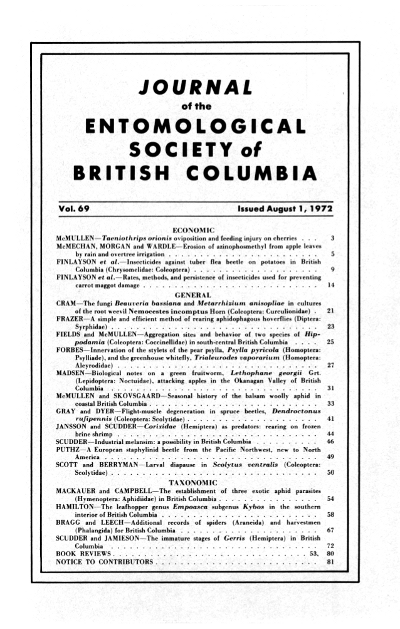Industrial melanism: A possibility in British Columbia
Abstract
Melanics of the Geometrid <i>Biston cognataria</i> Guenee have been recorded from the comparatively polluted Vancouver area of British Columbia. At present the genetic basis and evolutionary significance of this is unknown.References
Askew, R.R., L.M. Cook, and J.A. Bishop. 1971. Atmospheric pollution and melanic moths in Manchester and its environs. J. AppL Ecol. 8:247-256.
Bishop, J.A., and P.S. Harper. 1970. Melanism in the moth Gonodontis bidentata: a cline within the Merseyside conurbation. Heredity, Lond. 25:449-456.
Clarke, C.A., and P.M. Sheppard. 1963. Frequency of the melanic forms of the moth Biston betularia (L.) on Deeside and into adjacent areas. Nature, Lond. 198:1279-1282.
____________1966. A local survey of the distribution of industrial melanic forms in the moth Biston betularia and estimates of the selective values of these in an industrial environment. Proc. Roy. Soc. London(B) 165:424-439.
Cook, L.M., R.R. Askew, and J.A. Bishop. 1970. Increasing frequency of the typical form of the peppered moth in Manchester. Nature, Land. 227:1155.
Ford, E.B. 1945. Polymorphism. Biol. Rev. 20:73-88.
Kettlewell, H.B.D. 1955a. Recognition of appropriate backgrounds by the pale and dark phases of Lepidoptera. Nature, Lond. 175:943.
__________1955b. Selection experiments on industrial melanism in the Lepidoptera. Heredity 9:323-342.
__________1955c. How industrialization can alter species. Discovery 16(12):507-511.
__________1956a. Further selection experiments on industrial melanism in the Lepidoptera. Heredity 10:287-301.
__________1956b. A resume of investigations of the evolution of melanism in the Lepidoptera. Proc. Roy. Soc. London (B) 145:297-303.
__________1958a. A survey of the frequencies of Biston betularia (L.) (Lep.) and its melanic form in Great Britain. Heredity 12:51-72.
__________1958b. Industrial melanism in the Lepidoptera and its contribution to our knowledge of evolution. Proc. 10th Int. Congr. Entomol. 2:831-841.
__________1961. The phenomenon of industrial melanism in the Lepidoptera. Ann. Rev. Ent. 6:245-262.
__________1965a. A 12-year survey of the frequencies of Biston betularia (L.) (Lep.) and its melanic forms in Great Britain. Entomologist's Rec. J. Var. 77:195-218.
__________1965b. Insect survival and selection for pattern. Science 148:1290-1296.
Kettlewell, H.B.D., and R.J. Berry. 1961. The study of a cline, Amathes glareosa Esp. and its melanic f. edda Staud. (Lep.) in Shetland. Heredity 61:403-414.
_________________1969. Gene flow in a cline, Amathes glareosa Esp. and its melanic f. edda Staud. (Lep.) in Shetland. Heredity 24:1-14.
Klots, A.B. 1964. Notes on melanism in some Connecticut moths. J. N.Y. Entomol. Soc. 72:142-144.
__________1966. Melanism in Connecticut Panthea furcilla (Packard) (Lepidoptera: Noctuidae). J. N.Y. Entomol. Soc. 74:95-100.
__________1968a. Melanism in Connecticut Charadra deridens (Guenee) (Lepidoptera: Noctuidae). J. N.Y. Entomol. Soc. 76:58-59.
__________1968b. Further notes on melanism in Connecticut Panthea furcilla (Packard) (Lepidoptera: Noctuidae). J. N.Y. Entomol. Soc. 76:92-95.
Owen, D.F. 1961. Industrial melanism in North American moths. Amer. Nat. 95:227-233.
__________1962. Parallel evolution in European and North American populations of a Geometrid moth. Nature, Lond. 195:830.
Sargent, T.D. 1971. Melanism in Phigalia titea (Cramer) (Lepidoptera: Geometridae). J. N.Y. EntomoL. Soc. 79:122-129.
Downloads
Published
Issue
Section
License
Authors who publish with the Journal of the Entomological Society of British Columbia agree to the following terms:
-Authors retain copyright and grant the journal right of first publication with the work simultaneously licensed under a Creative Commons Attribution License that allows others to share the work with an acknowledgement of the work's authorship and initial publication in this journal.
-Authors are able to enter into separate, additional contractual arrangements for the non-exclusive distribution of the journal's published version of the work (e.g., post it to an institutional repository or publish it in a book), with an acknowledgement of its initial publication in this journal.
-Authors are permitted and encouraged to post their work online (e.g., in institutional repositories or on their website) prior to and during the submission process, as it can lead to productive exchanges, as well as earlier and greater citation of published work (See The Effect of Open Access).


